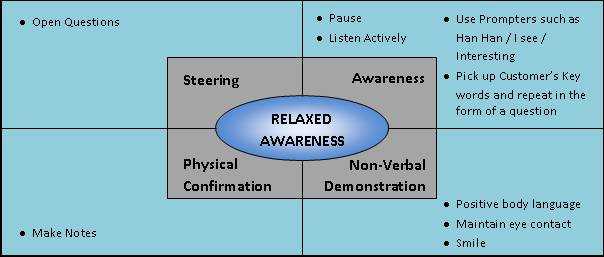Can you answer these three questions?
- Have you wondered why an ‘open’ question is called so?
- Is asking questions part of active listening skills? Why?
Can you solve the following three problems?
- A school hostel enquiry for 100 bunk bed stands (steel stands each with 2 beds one above the other) was answered by a large furniture company from organized sector. The local fabricator companies had also quoted for the tender. Their prices were about half of the large company. Salesperson of the large furniture company noticed that one key difference between others’ offer and her company stands was as follows. Her company stands were supplied as prefabricated component parts to be assembled at site, whereas the fabricators would fully fabricate and weld the stands onsite. Using this difference, she was able to get the order in spite of the price difference. What could she have done?
- An engineering company sells its products and solutions to other engineering companies. At their annual sales conference a successful sales engineer stated that most of their Customers’ orders were primarily decided on emotional factors including security, prestige & sense of power, rather than pure cost benefit analysis. He hastened to add that cost benefit analysis was not only important but eventually had to be done in each case to win the order. Some colleagues disagreed saying there is no place for emotions in purchases in engineering industry. Some colleagues shared his view. A heated debate ensued between two groups. What is your view?
- ‘Chinese Whispers’ is a popular game in which a message is whispered by one person in the ears of next person who in turn whispers to the next and so on, till it reaches the last person. Almost invariably the message ends up being completely distorted as received by the last person. The game illustrates a need for the clearest possible delivery of message for an effective communication process and is useful for highlighting things such as bad communication leads to organizational gossip. However, it does not fully help in training and development for effective communication with Customers. Why?
Business of online sales is growing. However a large proportion of business is still transacted through Personal Sales. Field sales people in these companies always say, in training and development programmes, that their job is essentially that of fulfilling the Customer’s needs. They are very honest when they say this, and sincerely try to do so. But the moot point is this. Are these salespeople clear on how to first understand the need of a given Customer and then try to fulfil that need with feature(s) of the product and service?.. Or, do salespeople aim to fulfil an assumed need?
Sadly, quite a few salespeople fall in latter category. The key rule in personal selling is: Never present a feature unless the need is clear.
- Need as recognized by the Customer.
- Not the need for a product, but need in the usage of product.
- Need as shaped by preferences of the Customer as an individual.
Asking questions and developing good listening skills is the only way to do all of above. Any training and development event for understanding Customers better must include training on questioning technique.
School Hostel management in the first problem above had plans to expand the hostel after year or two. This fact was not part of the tender information but was revealed to the salesperson through systematic probing and her good listening skills. Therefore easy-to-assemble bed bunker stands were preferred to avoid of hassles of retendering. That was the need in the product rather than the need for the product.
Knowing how to ask questions and what questions create what effects, is the art and science of asking questions. Effective communication also emphasizes listening skills and therefore use of good questions is part of training and development for active listening skills. If the participants of Chinese Whispers were encouraged or allowed to ask questions to the previous person, the end message might be less distorted!
Types of questions
Open questions start with the following words: What, Where, Why, How, Who, When, Which. An open question is called so since the person who asks questions is open to information. Using more open questions is very helpful to define the Customer’s requirements well. The open questions by which we do not give any direction to Customer’s answer are called as Open Neutral Questions (ONQ). If the open question aims to influence the Customer’s answer in a particular direction then it is called an Open Leading Question (OLQ). Asking good OLQ requires great listening skills, because you have to formulate it quickly based on what the Customer is saying to you in response to an ONQ.
If the question is such that we are only seeking either decision or confirmation or both, of what we believe we know, then we are closed to information and hence it is a closed question. Such a question would normally start with words Is, Am, Are, Do, Can, Have. While there is a time and place to ask closed questions, too many of them and asked without motivation can irritate the Customer since it looks like a detective.
Funnel Technique for asking questions – A powerful tool to encourage the flow of conversation:
‘Funnel Technique’ is a proprietary working tool of Mercuri International. This is not to be confused with what is commonly called as a Sales Funnel – sometimes used for forecasting. Funnel Technique, which is a questioning technique, starts with motivating the Customer (existing or new), asking open neutral questions to get unbiased information, asking open leading questions to probe more deeply and closed questions to pinpoint precise requirements. At the end of the funnel, summarizing improves the effectiveness of the sales call. See illustration of the funnel technique below.

DEFINING THE CUSTOMER’S REQUIREMENTS
Controlling the call by Funnel Technique
Key step is step 1 – motivating the Customer to answer questions. Otherwise, he will get irritated and not understand why he is expected to put up with what he will see as ‘questioning’. Although this step looks easy it is not. It must be covered well in any training and development programme.
Asking questions is not “questioning” the Customer
Use of questions in funnel technique must not be done to carry out “questioning”, but to carry out a conversation. Nine supplementary tools shown in the visual below will help convert the funnel technique to conversation skills and help create an excellent rapport.

- Can you now look again at your answers to the questions at the start of this monograph?
Understanding Customer Needs – The Power Of Questions


